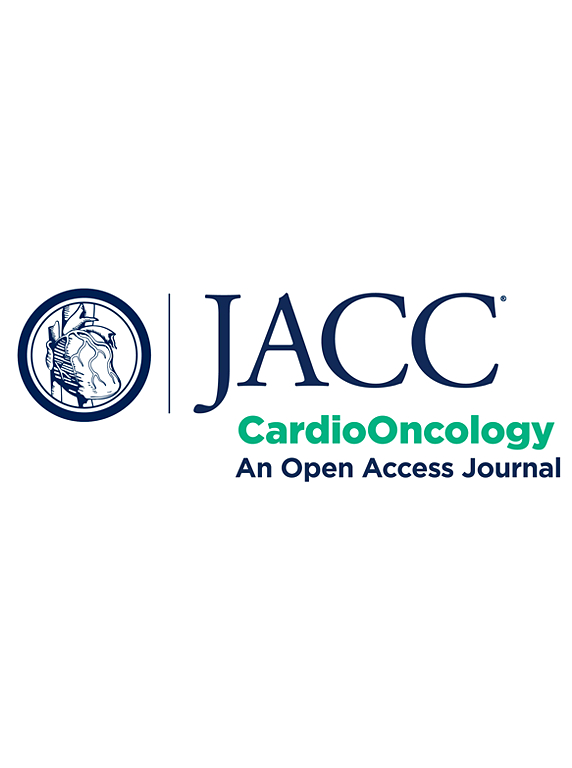免疫检查点抑制剂治疗患者c反应蛋白和静脉血栓栓塞的早期变化
IF 12
1区 医学
Q1 CARDIAC & CARDIOVASCULAR SYSTEMS
引用次数: 0
摘要
背景:接受免疫检查点抑制剂(ICIs)治疗的癌症患者发生静脉血栓栓塞(VTE)的风险很大。ici诱导的炎症与高凝性之间的关系尚不清楚,目前也没有生物标志物对静脉血栓栓塞风险进行分层。目的:作者试图确定ICI开始后c反应蛋白(CRP)的早期变化与静脉血栓栓塞风险之间的关系。方法:本回顾性队列研究纳入了来自2个学术癌症中心的开始ICI治疗的癌症患者,作为发现和外部验证队列。根据ICI治疗前3个月的CRP轨迹对患者进行分层,CRP升高定义为比基线增加2倍。在ICI治疗期间对患者静脉血栓栓塞进行随访,并使用竞争风险和时间依赖性分析。结果:共纳入822例患者。在发现队列(n = 405)中,CRP升高的患者(n = 159, 39.3%)的累积静脉血栓栓塞发生率为19.9% (95% CI: 8.4%-34.8%),而CRP未升高的患者的累积静脉血栓栓塞发生率为8.6%(3.1%-17.6%)。在调整了关键的患者和癌症特异性混杂因素后,CRP升高患者VTE的亚分布HR为2.64 (95% CI: 1.06-6.62)。这在外部验证队列中得到证实(n = 417;子分布HR: 2.25;95% CI: 1.03-4.94), CRP升高的患者VTE发生率为22.9% (95% CI: 9.7%-39.3%),无CRP升高的患者VTE发生率为10.8% (95% CI: 7.4%-15.1%)。在时间依赖性分析中证实了CRP升高与静脉血栓栓塞风险之间的关联,并且在调整疾病进展作为潜在的时间依赖性混杂因素后是一致的。结论:ICI治疗期间早期CRP变化与VTE风险增加相关,提示ICI诱导的炎症与高凝性之间存在潜在关联。CRP轨迹可作为ici相关静脉血栓栓塞的生物标志物。本文章由计算机程序翻译,如有差异,请以英文原文为准。
Early Change in C-Reactive Protein and Venous Thromboembolism in Patients Treated With Immune Checkpoint Inhibitors
Background
Patients with cancer treated with immune-checkpoint inhibitors (ICIs) have a substantial risk of venous thromboembolism (VTE). The association between ICI-induced inflammation and hypercoagulability is unclear, and no biomarkers currently exist to stratify VTE risk.
Objectives
The authors sought to determine the association between the early changes in C-reactive protein (CRP) after ICI initiation and the risk of VTE.
Methods
This retrospective cohort study included patients with cancer initiating ICI therapy from 2 academic cancer centers, serving as discovery and external validation cohorts. Patients were stratified based on CRP trajectories during the first 3 months of ICI treatment, with a CRP rise defined as a 2-fold increase from baseline. Patients were followed for VTE for the duration of ICI therapy, and competing risk and time-dependent analyses were used.
Results
A total of 822 patients were included. In the discovery cohort (n = 405), the cumulative VTE incidence in patients with a CRP rise (n = 159, 39.3%) was 19.9% (95% CI: 8.4%-34.8%), compared with 8.6% (3.1%-17.6%) in those without a CRP rise. After adjusting for key patient- and cancer-specific confounders, the subdistribution HR for VTE in patients with a CRP rise was 2.64 (95% CI: 1.06-6.62). This was confirmed in the external validation cohort (n = 417; subdistribution HR: 2.25; 95% CI: 1.03-4.94), with VTE incidences of 22.9% (95% CI: 9.7%-39.3%) in patients with a CRP rise and 10.8% (95% CI: 7.4%-15.1%) in those without. The association between CRP rise and VTE risk was confirmed in a time-dependent analysis and was consistent after adjusting for disease progression as a potential time-dependent confounder.
Conclusions
Early CRP changes during ICI therapy are associated with an increased risk of VTE, suggesting a potential association between ICI-induced inflammation and hypercoagulability. CRP trajectories may serve as a biomarker for ICI-associated VTE.
求助全文
通过发布文献求助,成功后即可免费获取论文全文。
去求助
来源期刊

Jacc: Cardiooncology
Multiple-
CiteScore
12.50
自引率
6.30%
发文量
106
期刊介绍:
JACC: CardioOncology is a specialized journal that belongs to the esteemed Journal of the American College of Cardiology (JACC) family. Its purpose is to enhance cardiovascular care for cancer patients by publishing high-quality, innovative scientific research and sharing evidence-based knowledge.
The journal aims to revolutionize the field of cardio-oncology and actively involve and educate professionals in both cardiovascular and oncology fields. It covers a wide range of topics including pre-clinical, translational, and clinical research, as well as best practices in cardio-oncology. Key areas of focus include understanding disease mechanisms, utilizing in vitro and in vivo models, exploring novel and traditional therapeutics (across Phase I-IV trials), studying epidemiology, employing precision medicine, and investigating primary and secondary prevention.
Amyloidosis, cardiovascular risk factors, heart failure, and vascular disease are some examples of the disease states that are of particular interest to the journal. However, it welcomes research on other relevant conditions as well.
 求助内容:
求助内容: 应助结果提醒方式:
应助结果提醒方式:


